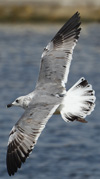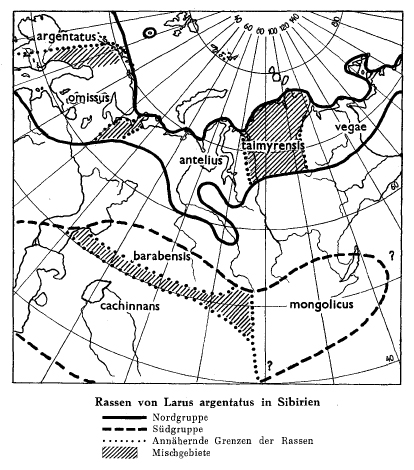 Heuglin's Gull (L. heuglini / antelius)
Heuglin's Gull (L. heuglini / antelius)
(last update:
Amir Ben Dov (Israel)
Chris Gibbins (Scotland)
Hannu Koskinen (Finland)
Mars Muusse (the Netherlands)
4cy / sub-adult heuglini: June
Characteristics and moult of "Baltic Lesser Black-backed Gull" Larus [fuscus] fuscus
and “Heuglin’s Gull" L. [fuscus] heuglini
Visa Rauste
 |
| (1, 2) 3CY heuglini. |
 |
THIS IS PART IV
BACK TO PART III
BACK TO PART II
BACK TO PART I
IMMATURE PLUMAGES
Siberian Gull Larus [fuscus] heuglini
Older immature birds
During the second winter, birds moult a variable number of body feathers and wing-coverts. In 3CY spring, the scapulars are usually similar grey as in adults. The wing-coverts -at least the primary coverts- still show variable degrees of scattered brown feathers, and the centres of the secondaries are darker than in adults. The tail is completely white or has irregularly dark markings, often a “broken tail-band”. Retarded 3CY individuals can be similar to most advanced 2CY birds. The bill is yellow with normally extensive black markings on the tip. The legs are yellow to grayish-pink and the eyes already bright as in adults, but can also be still quite dark.
Slightly retarded birds can easily be assigned to this age group, based on the extensive brown wing-coverts and dark brown primaries. Birds which lack obvious brown tones and show adult-like primaries are greater challenges to age.
 |
| (3, 4) subadult heuglini. |
It is unclear to what extent 4CY bird still show immature characteristics in spring. Tentatively birds which only show limited brown in the coverts and virtually adult-like primaries, should be best considered “subadult“ (or 3/4CY) until we better understand the variability of this age group.
In early September, when the moult is still in progress and the outer primaries are still old and normally 2nd generation, it is quite easy to distinguish 3CY birds in flight from older birds. The most advanced birds, however, are barely distinguishable from those in 4CY, and when studying a group of standing birds it is best to combine all birds into one “subadult” group, when they are not obvious 3CY birds.
Many “subadult” Siberian Gulls differ from adult in early-autumn by the straw-yellow legs and bill and by dark eyes. The upperpart grey tone on the other hand is mostly identical to that of adults. However, at least two birds in Archangelsk showed paler upperparts.
From 3CY spring onwards, Siberian Gull show adult-like grey feathers in the upperparts which allow identification from all other forms in their distribution range; to distinguish birds from graellsii is as difficult as in adult plumage. Possibly there are differences in the timing of acquiring adult-like plumage, but this certainly reflects great individual variability and will hardly lead us to robust identification criteria.
|
LINK & MAP Larus cachinnans |
Calls and behaviour
These points are often taken as criteria for identification in large white-headed gulls, however, the features are not treated into details here, since no significant differences are known to exist between the treated taxa and a more detailed analysis is still pending. Almost all types of calls of most large gulls are very similar, but with appropriate experience they can be distinguished from each other or at least give hints.
Notwithstanding the similarity in sounds, one taxon clearly differs in several calls: Caspian Gull. The long-call is long and in fast staccato, and this distinguishes it very clearly from both Herring Gull and Lesser Black-backed Gull. Also juvenile calls of Caspian Gulls are very conspicuous, as they combine the rhythm of the adult long-call with a harsh, nasal tone. With some experience, both types of calls can be easily isolated from the melee of calls in a group of gulls.
|
LINK & MAP Larus [fuscus] heuglini (?) |
It is often possible to distinct Lesser Black-backed Gull calls from those of Herring Gulls; Lesser Black-backed Gulls have deeper, nasal calls, and the long-calls are significantly longer. However, it requires much experience and it is often not possible due to individual variations. Still, there are no consistent differences documented for calls between fuscus and the western Lesser Black-backed Gulls or between fuscus and heuglini. (sound gallery on this site, MM.)
The calls, which were heard from Siberian Gulls during the stay in Archangelsk, did not differ from calls of Finnish Baltic Gulls, at least in our ears. Also the Siberian Gulls in Finland were not located on deviant calls.
When possible both Baltic Gulls as Siberian Gulls use landfills as a major food resource. (As with fuscus, this may reflect a trend from recent years, at least it contradicts earlier views.) A large proportion of the Baltic Lesser Black-backed Gulls on Finnish landfills is immature or subadult, but also full adult birds occur in large numbers. And in Siberian Gull too, the use of landfills is by no means limited to certain age-classes or seasons.
The behaviour of both forms on landfills does not differ significantly from that of Herring Gulls, except that they are often displaced from the best feeding loactions due to their lower body mass. Therefore, they are frequently observed at the edges of the landfill, where direct competition by Herring Gulls is lower. Possibly they have a stronger preference for shredder “Bio-waste”, which is temporarily stored before composting, but this impression may also relate to the displacement from the central area of the landfill.
Both fuscus and heuglini occasionally impress, intimidate and threaten with open wings. They adopt an “albatross-pose”, which has been described to occur commonly in Caspian Gull (Klein & Buchheim 1997, Klein & Gruber, 1997), but the process appears less ritualized. Accordingly, both fuscus and heuglini show this behaviour less frequent and less intense compared to cachinnans.
Possible hybridization
Hybrids between fuscus and heuglini?
 |
| (5, 6) true fuscus, or heuglini influences? |
 |
After Filchagov et all (1992, and according to M. Hario, in lit.) no fuscus breed on the Kola Peninsula; in the White Sea it only nests in the Onetzki-Bay and sporadically in the western Kandalaksha-Bay. Heuglini occupies large parts of the White Sea coast and also the interior of the Kola Peninsula. Fuscus has been forced to withdraw to a restricted area along the coast over the last decades, and currently this population is geographically isolated.
However, fuscus did breed on the Kola Peninsula (M. Hario in lit. after museum material), and it is unclear whether there has been hybridization; still it is unclear if hybridization occurs at all, anywhere in the range. There are two observations, from Finnish landfills, of heuglini-type birds apparently paired to fuscus (Kuusamo June 1997, H. Jannes & J. Peltomaki pers. corr, Oulu May 1998, pers. obs.). There are also few observations of birds with intermediate characteristics. The only such bird I've seen was a fuscus-like bird (in Kuusamo in June 1998), which had the upperparts slightly, but significantly, paler than other fuscus, somewhat “in the middle” between fuscus and heuglini. Possibly such supposed hybrids may still fall in the range of variation of pure fuscus (or intermedius?). Based on the rarity of such supposed hybrid birds, we may conclude hybridization occurs only very rarely –if it occurs at all-.
Hybrids between argentatus and heuglini?
 The opinion that heuglini may hybridize with Herring Gulls was repeated recently by Beaman & Madge (1998). This view, also cited in Glutz von Blotzheim & Bauer (1982) and Cramp & Simmons (1983) goes back to a map, published by Johansen (1960), showing a “mixed breeding area” between Larus argentatus antelius (= heuglini) and L. a. omissus (= argentatus), and a short comment on this by Stegmann (1960). However, it is unclear whether Johansen truly meant hybridization (and if so, on what basis), and actually Stegmann speculated "... that one can hardly doubt about the possibility of numerous crossings between the two forms”. On the other hand, Stegmann wrote already in 1934: “On the western border, where the form antelius [= Heuglini] meets pale-backed argentatus, there are no observations of intermediate birds. Both forms on the borders of their distribution breed close to each other, partially in the same area, without mixing, as like they are different species." Filchagov & Semashko (1987, in Hario 1992) reported sympatric breeding of the forms in the Ondomsk Lake (even on the same islands), with no signs of hybridization observed, and Filchagov (1994) found that “L. f
The opinion that heuglini may hybridize with Herring Gulls was repeated recently by Beaman & Madge (1998). This view, also cited in Glutz von Blotzheim & Bauer (1982) and Cramp & Simmons (1983) goes back to a map, published by Johansen (1960), showing a “mixed breeding area” between Larus argentatus antelius (= heuglini) and L. a. omissus (= argentatus), and a short comment on this by Stegmann (1960). However, it is unclear whether Johansen truly meant hybridization (and if so, on what basis), and actually Stegmann speculated "... that one can hardly doubt about the possibility of numerous crossings between the two forms”. On the other hand, Stegmann wrote already in 1934: “On the western border, where the form antelius [= Heuglini] meets pale-backed argentatus, there are no observations of intermediate birds. Both forms on the borders of their distribution breed close to each other, partially in the same area, without mixing, as like they are different species." Filchagov & Semashko (1987, in Hario 1992) reported sympatric breeding of the forms in the Ondomsk Lake (even on the same islands), with no signs of hybridization observed, and Filchagov (1994) found that “L. f
fuscus, L. argentatus and L. a. heuglini in the White Sea, where they occur sympatrically, are reproductively isolated. “ As long as no clear evidence is found for hybridization between heuglini and argentatus, speculations should be ended.
Acknowledgements
Many thanks to all who have contributed in one way or another to the development of this work, be it through comments on the draft, discussions about gulls, providing photos and other information, or assistance with field work:
Valeri Andreev, Theo Bakker, Sampsa Cairenius, Kari Eischer, Toni Eskelin, Dick Forsman, Detlef Gruber, Jyri Heino, Lars Jonsson, Matti Kapanen, Hannu Kettunen, Janne Kilpimaa, Hannu Koskinen, Merja Kyto, Petri Lampila, Harry J. Lehto, Henry Lehto, Tom Lindroos, Tero Linjama, Matti Luostarinen, Heikki Luoto, J. Pekka Nikander, Tapani Numminen, Jari Peltomaki, Arto Puikkonen, Jouni Pursiainen, Petro Pynnonen, Dirk Raes, Markku Rantala, Matti Rekila, Pekka Saikko, Kari Soilevaara, Harri Taavetti, Sami Timonen, Petteri Tolvanen, Jorma Tuomainen and Kari Vepsalainen.
The Zoological Museum of the Finnish Museum of Natural History, Helsinki gave me access to the collection and ring data. Martti Hario made Russian literature accessible for me, and was particularly helpful in his comments on the manuscript. I owe special thanks to Annika Forsten, Hannu Jannes and Antero Lindholm for valuable support. Axel Muller translated the text and made many other suggestions for improvement.
Chris Husband corrected the summary. The biggest thanks goes to Risto Juvaste, initiator of the Finnish colour-ring program for gulls and founder for better understanding of plumage development in “Baltic Lesser Black-backed Gulls”.
END OF PART IV
BACK TO PART I
BACK TO PART II
BACK TO PART III
CONTINUE AT PART V (summary & literature)